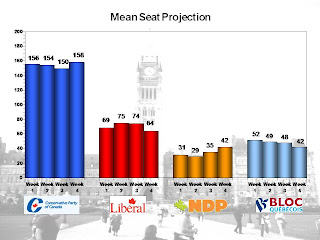Trying to make sense of what the NDP’s Quebec surge means in terms of seats is a difficult game. For starters, most public polls lump all of Quebec together when, in reality, a voter in Montreal is very different from a voter in Abitibi. Just because the Liberals or Conservatives are down province-wide, it doesn’t mean their incumbents are in danger, because their vote is so concentrated.
Even more challenging is trying to understand how a surge like this will be spread across the province. Most seat projections use the 2008 election as their baseline – my model is based primarily on 2008, but it also factors in the previous 2 elections and a regression “prediction” based on riding demographics. I think that’s a key improvement since it includes information about the voters, not just how they’ve voted in the past, but even then, all that data is from the old reality. We’re living in a very new reality.
If the NDP doubles or triples their Quebec-wide vote, it’s impossible to predict what the impact will be in each individual riding. The simulation model I use factors this in to a certain extent, which is why I report the probability of a given seat going to each party, rather than boldly saying if they’ll will win or lose. But the end result of this is a 95% confidence interval for NDP seats in Quebec of 3 to 19 – that’s hardly a precise target, and there are a lot of seats they have between a 4% and 8% chance of winning…with a few more polls showing the Dippers in first, that range will creep up.
Pundits Guide has a good article on the danger of taking these projections as the gospel truth. It’s also important to remember that a lot can change in a week – just because something is projected today, it doesn’t mean it will come to pass on May 2nd.
So with all those caveats, here’s where we stand with 7 days to go (change since last week in brackets):
CPC 38.6% (+0.5)
Lib 25.7% (-1.3)
NDP 22.0% (+1.9)
BQ 7.6% (-0.7)
Green 5.1% (-0.4)
Keep in mind that with the exception of a turkey-dinner fueled Nanos poll, we haven’t seen data from any phone calls conducted since last Wednesday (NOTE – I ran this before today’s Innovative and Environics polls were released).
So the above vote and the following seat projections could very well change significantly in the coming days. As such, I’ll be back with updated projections later this week, a closer look at the seats to watch in each region over the weekend, and a final projection on Sunday night. Also, I’ll post daily seat projections on Twitter.
Not surprisingly, the largest NDP movement has come in Quebec, where they’ve gone from a 0-7 seat range last week, up to a 3-18 range this week. These gains have come almost exclusively at the Bloc’s expense, with Liberal and Conservative seat ranges in Quebec unchanged from last week:
To get a better sense of how well the model is handling the wacky world of Quebec politics, consider the following two riding polls, released today (and fielded last week):
Brome Mississquoi – Bloc 32%, Lib 26%, NDP 26%, CPC 11%
Chambly Borduas – Bloc 37%, NDP 24%, Lib 15%, CPC 7%
Comparatively speaking, my model has Brome as a 35% chance of going Bloc, 35% chance of going Liberal, and 28% chance of going NDP. Which makes a lot of sense given the riding survey findings. It also underscores why a probability model is so much better for these kind of ridings. A simple projection would just put it down as a Bloc victory, without recognizing there’s a very good chance the Liberals and NDP could very well win it.
In Chambly, I still show the Bloc with a 96% chance of winning, with the NDP at just 4% – once again, this is consistent with the riding poll that has the Bloc up by 13 points.
